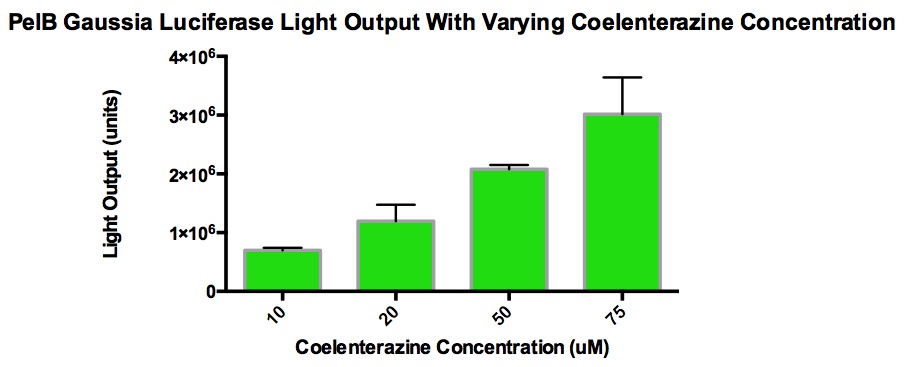Part:BBa_K1732005
J23100-B0034-Renilla-B0015
J23100-B0034-Renilla-B0015
Sequence and Features
- 10COMPATIBLE WITH RFC[10]
- 12INCOMPATIBLE WITH RFC[12]Illegal NheI site found at 7
Illegal NheI site found at 30 - 21INCOMPATIBLE WITH RFC[21]Illegal BamHI site found at 832
Illegal XhoI site found at 641 - 23COMPATIBLE WITH RFC[23]
- 25INCOMPATIBLE WITH RFC[25]Illegal AgeI site found at 265
- 1000COMPATIBLE WITH RFC[1000]
This sequence has been codon optimized for E. coli and is used to produce optimal amounts of Renilla luciferase so that it can be used to compare the luminescence as measured by standard luminometers as well as other DIY luminometers.
pSB1C3 backbone (part:pSB1C3) with J23100 promoter (BBa_J23100) and RBS (BBa_B0034), Renilla (BBa_52008), and B0015 terminator (BBa_B0015).
Renilla Luciferase, also known as Rluc, is a protein that emits light when coelenterazine is added. Rluc can be used as a reporter to track other proteins or to monitor the activity of a promoter (iGEM 2006_Slovenia).
Bioluminescent Mechanism of Coelenterazine
Coelenterazine is found in several aquatic organisms and is a luminescent substrate for many luciferase enzymes. For this study, Renilla Luciferase interacted with coelenterazine to determine relative light output and kinetics [3].
The image above is the chemiluminescent mechanism of coelenterazine. The bioluminescent mechanism is similar, except that the excited state molecule in bioluminescent is phenolate anion instead of the amide anion [2].
Before running experiments with Renilla Luciferase, the location of the luciferase in the media was determined by comparing the light output of overnight grown culture of Renilla cells with those of the pellet and the supernatant. The enilla culture was spun down, and the pellet represented intracellular localization while the supernatant represented extracellular localization.
It was expected that Renilla Luciferase was localized in the cell, and the level of light output from the pellet matched that of the overnight culture and was significantly higher than that of the media. This suggested that the luciferase is located intracellularly.
| None |






